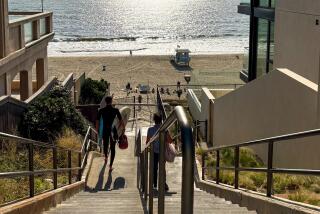His Regards to Broadway, L.A. Style
The two women are 70 years old now, but their legs dangling from a ledge four stories above 3rd Street just west of Broadway are as well turned as ever, if a little weathered.
Also catching the eyes of passers-by are the Longhorn cattle skulls and the other terra cotta and stone statues and ornaments that decorate the north facade of the Million Dollar Theater.
Appearing particularly proud and determined on the Broadway facade of that theater are the bison head corbels supporting a ledge above third-floor level that features a procession of stylized statues depicting the fine arts.
The decorations and the flamboyant Spanish Baroque design of the theater at 307 S. Broadway are among the more engaging on a street that happily contradicts the cliched image of Los Angeles as a chaotic collection of antiseptic shopping centers, anonymous office parks and subdivisions.
Sprinkled along Broadway in the lobbies of the great movie palaces there, on the buildings and on the street itself, are decorations that remind one of the rich history and architectural heritage of the city’s once premiere promenade.
They also are a reminder that to really appreciate, and enjoy, the art and craft of such expressive and exuberant architectural detailing, one has to experience it at leisure, up close, and perhaps even touch it.
To appreciate such small design touches, windshield surveys, as I reported on here a few weeks ago, just won’t do, certainly not on Broadway. With its ebb and flow of lively crowds shopping, strolling and gawking, the street is the city’s most urban and, for me, a welcome periodic diversion from viewing the present-day array of market-researched and manipulated designs in more suburban areas.
One can look at the Million Dollar Theater almost every day and still see something new on its Churrigueresque facade, said to be have been sculpted by Joseph Mora. (The florid style is named after its originator, Jose de Churriguera, an 18th-Century architect.)
The building was designed by the firm of Albert C. Martin Sr., and when opened in 1917 was hailed as the first, great motion picture “palace.” After all, it did cost showman Sid Grauman $1 million to build, a then unheard-of sum to spend on such a structure. (Grauman eventually would spend more creating the Egyptian and Chinese theaters on Hollywood Boulevard.)
One also can peek into the interior of the Bradbury Building across the street at 304 S. Broadway again and again, and still be impressed and enchanted by the lace-like wrought iron railings and bird cage elevators bathed in a brilliant light filtered through a skylight and reflected off pale yellow glazed brick walls.
Looking at this Romanesque magnificence designed nearly a century ago by George Wyman, it is easy to understand the dated architectural adage that the essence of a building is in its details.
Unfortunately, it is an adage too often forgotten in the embrace of today’s self-conscious designs abusing such materials as chain link fence and corrugated metal.
And talk about detailing, check out the sidewalk in front of McDonald’s, at 330 S. Broadway. The design in tile there was executed by Frank Romero. His work also can be seen on the southeast corner of Broadway and 4th Street, and the northwest corner of Broadway and 7th Street.
For literally the best sidewalk scene in town, take a look at the pavement in front of Clifton’s Cafeteria, 648 S. Broadway. There in a terrazzo of marble chips and cement are 12 visions of an idealized Southern California of the 1930s.
The scenes around a starburst pattern include the beaches, the missions, the orange groves (with snow-capped mountains in the background), the La Brea Tar Pits, the oil fields, a movie studio, the Hollywood Bowl, Catalina, the Coliseum and City Hall.
The artist given credit for this delight created in 1934 is the Venetian Terrazzo & Mosaic Co., a fact I learned from a marvelous, if spare, guide to public art downtown recently compiled by the city’s Community Redevelopment Agency. The guide lists 150 pieces of art, including sculpture, murals and architectural ornaments that can be viewed from the street and public plazas.
The only place one can now purchase the guide (priced at $9.95) is in the bookstore at the new Museum of Contemporary Art, 250 S. Grand Ave. (and not a bad place, either, to visit).
Less detailed but also less expensive is a brochure, “A Walking Tour of Downtown Los Angeles,” put together by the Los Angeles Conservancy. It can be purchased for $2 at the office of the conservancy, tucked into the mezzanine of the Eastern Columbia Building, 849 S. Broadway. It is open 9 to 5 weekdays.
The light green terra-cotta tiled, Moderne-styled Columbia building is itself a delight of sensitive detailing and expressive decorations, and definitely worth a long look. Indeed, so are a host of other buildings along Broadway and neighboring streets, but that will have to await another weekend.
More to Read
The biggest entertainment stories
Get our big stories about Hollywood, film, television, music, arts, culture and more right in your inbox as soon as they publish.
You may occasionally receive promotional content from the Los Angeles Times.










